

Ancient Japan - The Ancient Japanese Empire. The Geisha, the traditional Japanese ideal of beauty Where did the Japanese come from?
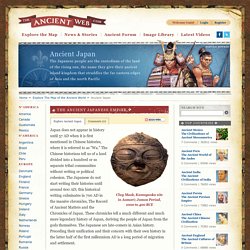
Why did they settle the islands? What did life look like before history was written down? In order to get a handle on ancient Japanese history, it helps to consider that it is driven by outside influences. Women in Ancient Japan: From Matriarchal Antiquity to Acquiescent Confinement. The role of women in ancient Japan elicits inconsistencies due to different influences that were integrated at various time periods.
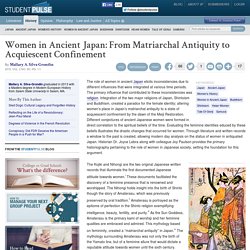
The primary influence that contributed to these inconsistencies was religion. Integration of the two major religions of Japan, Shintoism and Buddhism, created a paradox for the female identity; altering women’s place in Japan’s matriarchal antiquity to a state of acquiescent confinement by the dawn of the Meiji Restoration. Different conjectures of ancient Japanese women were formed in direct correlation to the spiritual beliefs of the time. Evaluating the feminine identities educed by these beliefs illustrates the drastic changes that occurred for women.
Through literature and written records a window to the past is created, allowing modern day analysis on the status of women in antiquated Japan. Japan's Mysterious Pyramids. Japanese History - Facts About Japan - Ancient Japan. The four islands that make up the Japanese archipelago have been inhabited by humans for at least 30,000 years—though some theories suggest the area was populated as long as 200,000 years ago!
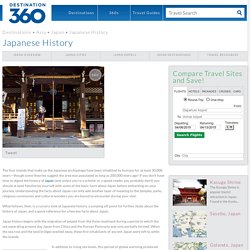
If you don't have time to digest the history of Japan (and unless you're a scholar or a speed reader you probably don't) you should at least familiarize yourself with some of the basic facts about Japan before embarking on your journey. Understanding the facts about Japan can only add another layer of meaning to the temples, parks, religious ceremonies and cultural wonders you are bound to encounter during your visit. What follows, then, is a cursory look at Japanese history, a jumping off point for further study about the history of Japan, and a quick reference for a few key facts about Japan. Japan - Ancient Cultures. On the basis of archaeological finds, it has been postulated that hominid activity in Japan may date as early as 200,000 B.C., when the islands were connected to the Asian mainland.
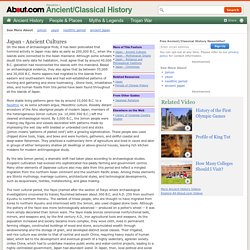
Although some scholars doubt this early date for habitation, most agree that by around 40,000 B.C. glaciation had reconnected the islands with the mainland. Based on archaeological evidence, they also agree that by between 35,000 and 30,000 B.C. Homo sapiens had migrated to the islands from eastern and southeastern Asia and had well-established patterns of hunting and gathering and stone toolmaking . Stone tools, inhabitation sites, and human fossils from this period have been found throughout all the islands of Japan.
More stable living patterns gave rise by around 10,000 B.C. to a Neolithic or, as some scholars argue, Mesolithic culture. By the late Jomon period, a dramatic shift had taken place according to archaeological studies. Ancient Japan. By Tim Lambert The First Japanese Human beings have lived in Japan for at least 30,000 years.
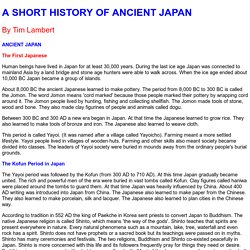
During the last ice age Japan was connected to mainland Asia by a land bridge and stone age hunters were able to walk across. When the ice age ended about 10,000 BC Japan became a group of islands. About 8,000 BC the ancient Japanese learned to make pottery. Between 300 BC and 300 AD a new era began in Japan. This period is called Yayoi. The Kofun Period in Japan The Yayoi period was followed by the Kofun (from 300 AD to 710 AD). According to tradition in 552 AD the king of Paekche in Korea sent priests to convert Japan to Buddhism. Furthermore in the 7th century AD the emperor became more powerful. Shotoku also built the Horyuji Buddhist temple and monastery in 607. After him, in 646, a series of reforms were made known as the Taika. Timeline Of Ancient Japan. The Ancient Japanese. Jomon Period: 10,000 B.C. – 400 BC Stable living patterns began to appear in Japan with the arrival of the Jomon people around 10,000 B.C.
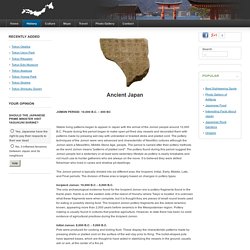
People during this period began to make open-pit fired clay vessels and decorated them with patterns made by pressing wet clay with unbraided or braided sticks and plaited cord. The pottery techniques of the Jomon were very advanced and characteristic of Neolithic cultures although the Jomon were a Mesolithic, Middle Stone Age, people. The period is named after their pottery methods as the word Jomon means "patterns of plaited cord". The pottery found during this period suggest the Jomon people led a sedentary or at least semi-sedentary lifestyle as pottery is easily breakable and not much use to hunter gatherers who are always on the move.
The Jomon period is typically divided into six different eras; the Incipient, Initial, Early, Middle, Late, and Final periods. Photos of Jomon period artifacts Yayoi Period: 400 BC – AD 250 Nara Period: 710 – 794.